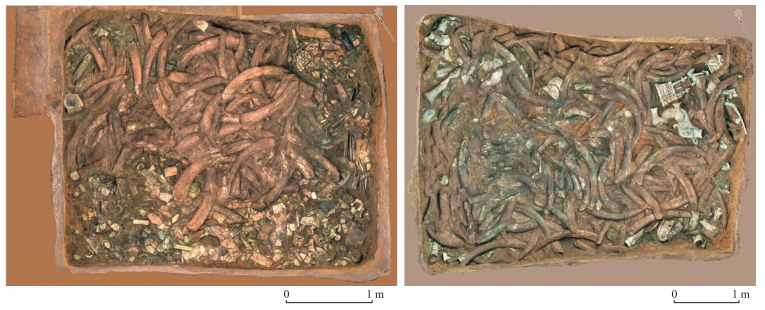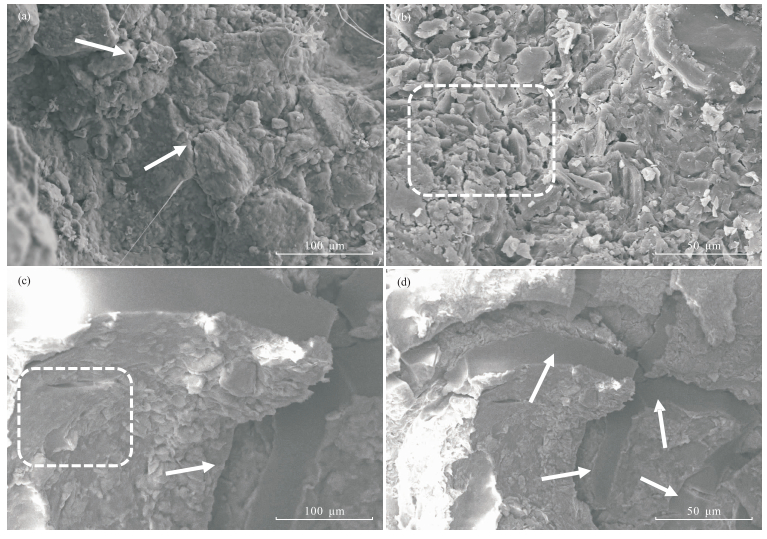A Study on the Reinforcement and Protection of Water-Saturated Ivory Artifacts Unearthed from the Sanxingdui Site
-
摘要:
三星堆遗址是迄今为止中国西南地区发现的分布范围最广、延续时间最长、文化内涵最丰富的古蜀文化遗址。该遗址出土的大量、成批的古象牙及象牙器文物具有重要的历史文化价值和科学研究价值。由于出土的象牙文物含水率高、酥粉严重,同时常规骨质文物加固材料(如羟基磷灰石、碳酸钙、Paraloid B72)等渗透性差,导致其加固效果欠佳。为了更有效加固与保护酥粉饱水象牙文物,在认识三星堆遗址出土象牙组成结构和病害类型的基础上,合成制备绿色柔性长链硅氧烷材料对酥粉饱水象牙文物样品进行滴渗加固实验研究,并采用电子万能试验机、静态水接触角测试仪和扫描电子显微镜对加固前后象牙文物的力学性能、微形貌特征和表面水浸润性能进行分析。结果表明,制备的硅氧烷加固材料在饱水象牙文物样品内的渗透性能较好,能够有效填充其孔洞缺陷,防止象牙本体收缩坍塌;加固后象牙文物的力学性能和疏水性能显著提高,且不改变文物原有形貌,是一种适用于潮湿环境下酥粉较为严重的出土饱水象牙文物加固材料。
Abstract:Sanxingdui site is the ancient Shu cultural ruins with the widest distribution, longest duration and richest cultural connotation found so far in southwest China. The large number of ancient ivory artifacts unearthed at this site have important historical, cultural, and scientific research value. Due to the high moisture content and serious crisp powder problem of the unearthed ivory artifacts, the conventional reinforcement materials for bone artifacts such as hydroxyapatite, calcium carbonate and Paraloid B72 have poor permeability and unsatisfactory reinforcement effect. In order to effectively protect ivory artifacts, the green flexible long chain siloxane material was synthesized, and the reinforcement experimental research was carried out by drip infiltration on the basis of understanding the composition structure and disease types of ivory artifacts unearthed at Sanxingdui site. The mechanical properties, micro-morphology and surface water infiltration of reinforced ivory artifacts were studied by means of electronic universal testing machine, scanning electron microscope and static water contact angle tester.The results showed that the prepared siloxane materials had good permeability in the water-saturated ivory artifacts, thus effectively filling the hole defects and preventing the collapse of the body. The mechanical properties and hydrophobicity of the ivory reinforced by the siloxane materials were significantly improved, and the original appearance of the ivory artifacts was not changed. The prepared siloxane materials were suitable for the reinforcement protection of the ivory artifacts with severe crispy powder problem excavated in humid environment.
-
Keywords:
- ivory artifact /
- water saturation /
- siloxane /
- reinforcement protection /
- Sanxingdui site
-
1986年,考古队在三星堆遗址发掘的两个祭祀坑共出土古象牙80余根,文保专家立即对其进行了一系列保护措施,并取得了一定的加固效果,但随服役时间的延长且受当时科技水平条件影响,原有加固材料不可避免产生老化分解,使得出土的象牙文物仍面临开裂、剥离等风险。2020年10月9日开始,四川省文物考古研究院联合我国多所高校和研究院共同对三星堆遗址前期祭祀区勘探和发掘过程中新发现的6座祭祀坑进行了考古发掘,该祭祀坑出土了大量、成批的古象牙及象牙器文物(图 1),这些文物的发现掀开了中国考古史的新篇章,为古蜀文化研究提供了重要材料,具有重要的历史文化价值和科学研究价值[1-8]。
![]() 图 1 三星堆K7、K8祭祀坑内象牙文物的埋藏情况[1]Figure 1. Burial of ivory artifacts in K7 and K8 sacrificial pits at Sanxingdui site
图 1 三星堆K7、K8祭祀坑内象牙文物的埋藏情况[1]Figure 1. Burial of ivory artifacts in K7 and K8 sacrificial pits at Sanxingdui site与新鲜象牙不同的是,三星堆遗址祭祀坑周边环境属于典型的南方潮湿环境,其出土的象牙含水率高,象牙内部孔隙时常吸附着大量水分,近乎饱水,内部结构及组分也发生了明显变化。同时象牙中起连接胶结作用的有机质逐步水解,不断流失,保存状况差,极其脆弱[9-11]。此外,由于水是强极性溶剂,羟基磷灰石微溶于水,象牙内部存在的可溶盐被溶解后,又增大了孔隙,致使内部结合力下降,导致出土象牙文物的力学强度也大幅降低[12]。若象牙文物一旦暴露在空气中,之前相对稳定的地下潮湿环境被打破,随着象牙内部水分的大量蒸发,那么其表面会逐渐分层、开裂、剥落,甚至崩解粉化,失去文物研究价值,因此亟需对这类出土象牙文物进行加固保护措施[13-14]。
研发和筛选渗透性良好、加固效果及耐候性能优良的加固保护材料一直是骨质文物保护领域的关键技术难题和重点研究方向。由于潮湿环境中出土的饱水象牙文物含水率过高、埋藏环境复杂,常规的骨质文物加固试剂如羟基磷灰石、碳酸钙、Paraloid B72等在饱水象牙文物中的渗透性能较差,加固效果不理想,且在潮气、高温、有害气体、光线等环境因素的影响下,加固材料会出现涂膜变硬、重量损失及可逆性降低等现象[15-17]。现有加固材料及技术均难以满足饱水象牙文物保护的要求,寻找到一种更适用于饱水象牙文物保护的新型加固材料尤为重要。硅氧烷加固材料种类众多,溶剂(仅有乙醇和水)和催化剂用量少,对环境无害、水解合成过程中不产生毒副产品、能源损耗低,具有绿色环保和低毒性的特点[18-21],通常具有相似的结构特性,其结构通式可用Y(CH2)nSiX3(0≤n≤3)来表示,X为可水解基团,Y则为非水解基团,当硅氧烷介于无机和有机界面之间时,可通过脱水缩合反应形成有机基体-聚硅氧烷-无机基体的结合层,充当连接无机材料与有机材料的桥梁[22-23]。此外,长链硅氧烷材料主链上的化学键有内旋转自由度的高分子长链,分子间的内旋转位垒较小,动态柔性好[24],并且水解后生成的硅醇之间发生脱水缩合反应生成具有Si-O-Si三维长链网络结构[25]的聚硅氧烷,该结构可显著提高骨质文物的韧性和力学性能。
基于硅氧烷材料的结构特征和反应机理,本文采用自行制备的柔性长链硅氧烷材料对酥粉严重的三星堆遗址出土饱水象牙文物样品进行滴渗加固实验研究,根据加固前后象牙文物的力学性能、静态水接触角和微形貌特征变化进一步分析了硅氧烷材料的加固效果和加固机理。
1. 实验部分
1.1 加固对象分析
实验所使用的象牙样品取自四川广汉三星堆遗址K7祭祀坑出土饱水象牙文物(编号:K7 XY-177),样品多为小块碎块,表面酥粉及开裂较严重,含水率较高,质量约为5 g,颜色主要为茶色、褐色、橄榄色等。经手工清理除杂,象牙样品被保存在低温高湿恒温箱内(T=5 ℃,RH=90%)以维持其内部水分稳定,防止破碎损坏。根据宏观形貌特征、含水率、红外光谱等测试表征手段对所取的象牙样品进行结构和成分的分析评估,充分了解所出土象牙文物样品的病害信息,为后续加固实验做好充足准备。
1.2 加固材料制备及加固实验
取适量硅氧烷A和具有功能官能团的硅氧烷B于烧杯中,并加入无水乙醇和去离子水,搅拌均匀后调节溶液pH值至4~5,水热合成制备硅氧烷加固材料。将合成制备的硅氧烷加固材料分别滴渗至象牙样品外侧面(致密面)及内侧面(糟朽面),自然干燥3 d后进行后续测试分析。
1.3 测试分析与表征
采用CMT 4104型微机控制电子万能试验机,按照中华人民共和国国家标准《塑料压缩性能试验方法标准GB/T 1041-92》测定加固前后象牙样品的抗压强度;采用JY-Pha型静态水接触角测试仪测试加固前后象牙样品的接触角变化,每个样品选取3个不同位点进行水滴接触角实验,然后采用弦切法对接触角进行计算,取3个位点接触角的平均值记为该样品表面的接触角;采用日本HITACHI公司生产的SU 8010扫描电子显微镜(SEM)对加固前后象牙样品的微观结构进行测试表征,测试条件:低真空模式,工作电压15 kV;采用美国Thermo Fisher公司生产的Nicolet IS50傅里叶红外光谱仪(FTIR)分析象牙样品的化学结构,测试条件:扫描范围4 000~400 cm-1,分辨率4 cm-1,扫描次数64次。相关测试均在中国地质大学(武汉)材料与化学学院大型仪器实验室内完成。
2. 饱水象牙文物病害分析
充分了解所处环境及周边相关因素对象牙文物造成的病害信息,是对象牙文物进行加固保护的重要前提。三星堆遗址祭祀区发掘出土的象牙文物由于受地表地下水、温湿度、土壤酸碱盐、微生物以及其他埋藏文物等主要环境因素的损坏下,整体病害较为严重,部分象牙文物存在大量明显的焚烧痕迹。关于焚烧的根源仍存在争议,但可以肯定的是,焚烧对象牙造成了极大的破坏。由于年代久远,被焚烧后的象牙文物与泥土连接,大多已泥化,力学强度极差。正是由于这些人为的焚烧破坏,错综乱杂的摆放与挤压,以及特殊的大气、土壤环境影响,再加上地质环境的变化和微生物的腐蚀霉变,使得所出土的象牙文物病害严重,力学性能极差,亟需加固保护。
2.1 宏观形貌特征和含水率分析
图 2和表 1分别为三星堆遗址祭祀坑出土K7 XY-177部分象牙文物样品的宏观形貌特征及其碎片的含水率,其中m1、m2分别为象牙碎片样品的初始质量和干燥后的质量,M和Mc分别为象牙碎片的含水率和平均含水率,M=(m1-m2)/m1×100%。由于祭祀坑内象牙文物样品存在饱水、糟朽、酥粉、剥离、残缺、裂隙、变形、局部断裂、变色、霉变、微生物损害等病害,象牙样品残损严重,保存状况较差;象牙样品的含水率较高,幅值为35.94%~37.39%,近乎饱水,这些水分导致象牙内部有机质严重分解,连接胶粘作用极差,力学性能极低。
表 1 三星堆遗址祭祀坑出土象牙文物样品的含水率Table 1. Moisture content of ivory artifacts unearthed from sacrificial pits at Sanxingdui site象牙碎片 m1/g m2/g M/% Mc/% 碎片1 1.051 2 0.658 2 37.39 36.64 碎片2 1.480 4 0.988 4 35.94 碎片3 0.785 5 0.498 2 36.58 2.2 红外光谱分析
三星堆遗址祭祀坑出土K7 XY-177部分象牙文物样品的红外光谱结果(图 3)显示,3 401.3 cm-1左右的宽峰归属于吸附在象牙微孔及裂缝中水分子的-OH对称和不对称伸缩振动吸收峰引起,水分子的-OH剪式弯曲振动吸收峰在1 639.2 cm-1被检测到,水分子的伸缩振动吸收峰强度较高,这说明象牙内部水分含量较多,易导致象牙酥粉分解;氨基酸的酰胺Ⅰ带在1 725.9 cm-1被检出,但酰胺Ⅱ带1 530 cm-1和酰胺Ⅲ带1 260 cm-1均未被检出,说明象牙内起连接胶结作用的蛋白质已几乎被分解殆尽,象牙的韧性和结合力急剧下降,这可能是出现严重开裂和掉渣现象的诱因[26];466.7、560.2、601.2 cm-1和1 016.3 cm-1左右出现的尖峰为磷酸盐中P-O的弯曲振动吸收峰和伸缩振动吸收峰所致,这几处特征吸收峰强度较高,说明象牙内部存在较多的磷酸盐成分,即象牙的主要成分为羟基磷灰石[27];1 451.7 cm-1和1 414.5 cm-1处的双峰分别为CO32-的不对称和对称伸缩振动峰所致,689.9 cm-1处的峰归属于CO32-的弯曲振动吸收峰所致,这说明CO32-部分替代了羟基磷灰石中的OH-位置(A型取代)或PO43-位置(B型取代),形成碳磷灰石(Ca5[PO4, CO3(OH)]3(F, OH))等多种磷灰石亚种[28-29]。
根据上述对三星堆遗址出土的象牙文物的成分和结构等表征分析可知,象牙内部主要成分为结晶度较差的羟基磷灰石及其亚种,起连接胶结作用的有机质成分几乎已消失殆尽,含水率较大,内部韧性和结合力较弱,对象牙文物的长期保存构成了严重威胁,如何加固保护此类象牙文物也成为公认的界内难题。
3. 硅氧烷材料加固效果评价
3.1 加固前后象牙的宏观形貌特征
图 4a和图 4b分别为加固前的饱水象牙样品的髓质和皮质,图 4c和图 4d分别为硅氧烷加固后的饱水象牙的髓质和皮质。加固前的饱水象牙髓质和皮质整体酥解较为严重,结构较为松散,轻触有大量细碎象牙颗粒掉落,表面有大量黑褐色物质存在,推测为祭祀坑内祭品焚烧所致。此外象牙表面较为湿润,这说明其内部有大量水分存在,含水率较高,象牙皮质整体强度大于牙髓质。经硅氧烷加固后的饱水象牙样品表面黑褐色物质减少,颜色变深但整体分布较为均匀,在自然环境干燥后仍能维持原有形貌,结构变得较为致密坚固,轻触基本无掉渣现象;此外,该硅氧烷加固材料在5 s内能完全渗入象牙内部,且加固后的象牙表面具有一层透明、无眩光的防护膜层,这说明该硅氧烷加固材料渗透性能良好,能在一定程度上对象牙起封护作用,且不改变文物外观,符合“文物保护的基本原则”。
3.2 力学性能分析
采用微机控制电子万能试验机对硅氧烷材料加固前后的饱水象牙样品进行抗压强度测试分析。结果(表 2)显示,加固前的饱水象牙样品1和样品2的抗压强度分别为0.17 MPa和0.21 MPa;经硅氧烷材料加固3 d后象牙样品的抗压强度增至0.28 MPa和0.34 MPa,压强增量分别为64.71 %和61.90 %,平均压强增量为63.31 %。与骨质文物常用加固材料丙烯酸树脂和水玻璃相比,经硅氧烷材料加固后的象牙样品整体抗压强度有较大的提升[30-31],掉渣现象也得到明显改善,皮质和髓质均获得了显著的加固,这说明该硅氧烷加固材料对饱水象牙文物本体有较好的固结和渗透作用,能有效渗入内部填充象牙孔洞缺陷,起到一定的支撑作用。
表 2 经硅氧烷溶液加固前后饱水象牙样品的抗压强度Table 2. Compressive strength of water-saturated ivory samples before and after reinforced with siloxane solution样品号 抗压强度/MPa 压强增量
/%加固前 加固后 1 0.17 0.28 64.71 2 0.21 0.34 61.90 3.3 静态水接触角分析
采用静态水接触角测试仪对硅氧烷材料加固前后的饱水象牙样品进行分析,探究硅氧烷加固材料对饱水象牙表面疏水性能的影响。实验结果(图 5)显示,未处理象牙样品表面的静态水接触角为0°,呈现超亲水特性,水分子易渗入至内部加速象牙的崩解;经硅氧烷材料加固3 d后象牙样品的静态水接触角增至96.8°,其表面呈现一定的疏水性,这说明硅氧烷材料在饱水象牙表面发生了成膜反应,生成了具有明显耐水性能的防护膜层,能有效防止外部水分侵入本体,具有一定的防护作用。
3.4 扫描电子显微镜分析
结合饱水象牙文物加固前后的宏观形貌特征及力学性能测试结果,对硅氧烷加固处理前后的饱水象牙样品进行扫描电子显微镜观察,比较研究加固处理前后的象牙样品微形貌变化特征,如图 6所示。
由图 6a和图 6b可知,未处理的饱水象牙本体呈疏松多孔的片层状结构,大部分孔道结构已经消失,保留有少量不连续的孔道及裂缝结构,不均匀地散布在象牙组织中;孔洞直径约为1~5 μm,为象牙小管结构,而小管边缘已变得不平整,并出现了坍塌现象;几乎观察不到有机纤维结构,致使饱水象牙力学性能急剧下降,易粉化损坏。
由图 6c和图 6d可知,与未处理饱水象牙相比,经硅氧烷加固后的饱水象牙样品内部致密平整,未出现崩解粉碎现象。此外,组织中仍具有平整光滑的小管结构,基本保持饱水象牙潮湿环境下的原有形貌。这说明该硅氧烷加固材料能显著提升饱水象牙的整体强度和抗崩解性能,具有较好的支撑和固结作用,也能维持饱水象牙原有形貌,对酥粉饱水象牙具有较好的加固效果。
4. 讨论
本文采用自行水热合成的硅氧烷加固材料对三星堆遗址出土的饱水象牙样品进行了加固保护研究和加固效果评价,其最大优点在于可通过水解缩合反应形成三维网络结构接枝于象牙内壁,并具有环境友好性和动态柔性好等特点,能较大程度提升象牙样品的力学性能和疏水性能。但由于三星堆出土象牙文物较为珍贵,样品相对较少且尺寸、状态和规格不一,力学性能和疏水性能评价难以进行绝对的判定,渗透性能也因象牙样品的状态和规格有所差异,需要进一步结合其他表征手段如X射线衍射仪、纳米压痕仪等进行综合分析,揭示加固机理。
由于化学材料加固仅是象牙文物保护过程中的其一步骤,清洗、除盐、粘结、拼接、防菌杀菌、封护等步骤在象牙文物保护修复过程中也存在不可或缺的作用,后续可将该加固材料和其他保护措施联用以进一步提高象牙文物的力学和疏水性能,形成象牙文物成套保护修复技术,更为高效地保护象牙文物。
此外,需要对加固材料的长效性进行动态追踪分析,开展紫外光老化、湿热老化、酸碱老化等室内加速老化实验研究,评估加固材料的使役性能;在此基础上开展普适性实验研究,将加固材料应用于更多象牙文物或其它骨质文物的加固保护研究,以获得更为客观、准确的效果评价。
5. 结论
本文采用自行配制的硅氧烷加固材料对三星堆遗址出土的饱水象牙文物进行了滴渗加固实验研究,并对饱水象牙样品加固前后的力学性能、微形貌特征和表面水浸润性能等结构与性能变化进行了分析,结论如下。
(1) 该硅氧烷材料渗透性能和加固性能良好,经加固后的饱水象牙样品结构变得较为致密坚固,轻触基本无掉渣现象,且表面具有一层透明、无眩光的防护膜层,但仍能维持原有宏观形貌特征,符合“文物保护的基本原则”。
(2) 该硅氧烷材料加固后的饱水象牙样品组织中仍具有平整光滑的小管结构,象牙矿物颗粒孔隙显著降低,结构更为致密平整,基本保持饱水象牙文物在潮湿环境下的原有微形貌特征。
(3) 该硅氧烷材料加固后的饱水象牙样品力学性能、抗崩解性能和疏水性能显著提高,加固3 d后的象牙样品抗压强度增至0.28 MPa和0.34 Mpa,表面静态水接触角增至96.8°,这说明该硅氧烷加固材料对饱水象牙文物有着较好的固结作用和成膜效果。
-
图 1 三星堆K7、K8祭祀坑内象牙文物的埋藏情况[1]
Figure 1. Burial of ivory artifacts in K7 and K8 sacrificial pits at Sanxingdui site
表 1 三星堆遗址祭祀坑出土象牙文物样品的含水率
Table 1 Moisture content of ivory artifacts unearthed from sacrificial pits at Sanxingdui site
象牙碎片 m1/g m2/g M/% Mc/% 碎片1 1.051 2 0.658 2 37.39 36.64 碎片2 1.480 4 0.988 4 35.94 碎片3 0.785 5 0.498 2 36.58 表 2 经硅氧烷溶液加固前后饱水象牙样品的抗压强度
Table 2 Compressive strength of water-saturated ivory samples before and after reinforced with siloxane solution
样品号 抗压强度/MPa 压强增量
/%加固前 加固后 1 0.17 0.28 64.71 2 0.21 0.34 61.90 -
[1] 冉宏林, 雷雨, 赵昊, 等. 四川广汉市三星堆遗址祭祀区[J]. 考古, 2022(7): 15-33. Ran H L, Lei Y, Zhao H, et al. Sacrificial area of the Sanxingdui site in Guanghan city, Sichuan[J]. Archaeology, 2022(7): 15-33. (in Chinese)
[2] 段渝. 三星堆: 神权文明的内涵[J]. 中国文化研究, 2021(4): 119-130. Duan Y. Sanxingdui site: The connotation of a theocratic civilization[J]. Chinese Cultural Studies, 2021(4): 119-130. (in Chinese)
[3] 杨博. 以考古丰富古史: 三星堆遗址的启示与谜思[J]. 中国文化研究, 2022(2): 73-79. Yang B. Enriching ancient history with archaeology: Revelations and mysteries of Sanxingdui site[J]. Chinese Cultural Studies, 2022(2): 73-79. (in Chinese)
[4] 冉宏林. 三星堆遗址考古工作九十年[J]. 中华文化论坛, 2023(4): 112-120, 190-191. Ran H L. Ninety years of archaeological work at Sanxingdui site[J]. Chinese Culture Forum, 2023(4): 112-120, 190-191. (in Chinese)
[5] Liu Y S, Xu Q M, Li S F, et al. Novel formulated alumina-silica hybrid sol for the entire consolidation of waterlogged decayed ivory from Sanxingdui ruin site[J]. Heritage Science, 2024, 12(90): 1-11.
[6] 肖嶙, 王宁, 蒋璐蔓, 等. 三星堆出土象牙多层级结构及失水过程研究[J]. 文物保护与考古科学, 2024, 36(2): 1-12. Xiao L, Wang N, Jiang L M, et al. Study on the multilayered structure and water loss process of ivory excavated from Sanxingdui site[J]. Science of Conservation and Archaeology, 2024, 36(2): 1-12. (in Chinese)
[7] 陈显丹. 三星堆遗址一、二号祭祀坑发掘日记[J]. 四川文物, 2006(3): 85-90. Chen X D. Diary of the excavation of the first and second sacrificial pits of Sanxingdui site[J]. Sichuan Cultural Relics, 2006(3): 85-90. (in Chinese)
[8] 四川省文物考古研究院. 三星堆祭祀坑[M]. 北京: 文物出版社, 1999: 150-154. Sichuan Institute of Cultural Relics and Archaeology. Sacrificial pits of Sanxingdui[M]. Beijing: Cultural Relics Press, 1999: 150-154. (in Chinese)
[9] 王惠珍. 文物保护学[M]. 北京: 文物出版社, 2009: 345. Wang H Z. Conservation of cultural relics[M]. Beijing: Cultural Relics Press, 2009: 345. (in Chinese)
[10] 张跃芬, 杨平, 余健, 等. 三星堆遗址祭祀区三号祭祀坑出土的象牙现场加固材料力学性能研究[J]. 中国测试, 2022, 48(202): 186-191. Zhang Y F, Yang P, Yu J, et al. Study on the mechanical properties of ivory field reinforcement materials excavated from No.3 sacrificial pit in the sacrificial area of Sanxingdui site[J]. China Test, 2022, 48(202): 186-191. (in Chinese)
[11] Reiche I, Vignaud C, Menu M. The crystallinity of ancient bone and dentine: New insights by transmission electron microscopy[J]. Archaeometry, 2002(44): 3.
[12] 徐海兵. 澄城县象牙化石病变机理及保护方法研究[D]. 西安: 西北大学, 2012. Xu H B. Research on lesion mechanism and protection method of fossilized ivory in Cheng cheng county[D]. Xi'an: Northwest University, 2012. (in Chinese)
[13] 邱泽皓. 杂化材料及其在古象牙文物保护中的应用研究[D]. 成都: 成都理工大学, 2006. Qiu Z H. Research on hybridized materials and their application in the protection of ancient ivory artifacts[D]. Chengdu: Chengdu University of Technology, 2006. (in Chinese)
[14] Howie F M. Development of treatments[M]. Oxford: Butterworths-Heinemann, 1995: 1-4.
[15] Oancea A V, Bodi G, Cernescu A, et al. Protective coatings for ceramic artefacts exposed to UV ageing[J]. npj Materials Degradation, 2023, 7(21): 1-13.
[16] He W B, Ou J F, Wang F J, et al. Transparent and superhydrophobic coating via one-step spraying for cultural relic protection against water and moisture[J]. Colloids and Surfaces A: Physicochemical and Engineering Aspects, 2023(662): 130949.
[17] Soytürk E E, Kartal S N, Terzi E, et al. Evaluation of wood treated with Paraloid B72 and boric acid: Thermal behavior, water absorption and mold resistance[J]. European Journal of Wood and Wood Products, 2023(81): 923-934.
[18] 聂焱. 金属表面有机硅烷杂化功能涂层的制备[D]. 青岛: 中国石油大学(华东), 2021. Nie Y. Preparation of organosilane hybridized functional coatings on metal surfaces[D]. Qingdao: China University of Petroleum (East China), 2021. (in Chinese)
[19] 杨超, 赵晨阳, 张继, 等. 纳米ZrO2的改性及其对硅烷防腐涂层的影响[J]. 上海涂料, 2024, 62(2): 1-6. Yang C, Zhao C Y, Zhang J, et al. Modification of nanometer ZrO2 and its effect on silane anticorrosion coating[J]. Shanghai Coatings, 2024, 62(2): 1-6. (in Chinese)
[20] 张磊, 徐枫, 杨红艳, 等. 绿色低碳硅烷改性聚醚防水涂料及其应用性能初探[J]. 中国建筑防水, 2023(4): 1-5. Zhang L, Xu F, Yang H Y, et al. Green low-carbon silane-modified polyether waterproof coating and its application performance[J]. China Building Waterproofing, 2023(4): 1-5. (in Chinese)
[21] 臧晓玲, 温变英. 高分子材料绿色制造与可持续发展[J]. 中国塑料, 2021, 35(8): 9-20. Zang X L, Wen C Y. Green manufacturing and sustainable development of polymer materials[J]. China Plastics, 2021, 35(8): 9-20. (in Chinese)
[22] Maija H, Mari H, Vippola M, et al. Effect of silane treatment parameters on the silane layer formation and bonding to thermoplastic urethane[J]. Progress in Organic Coatings, 2011, 72(4): 716-723.
[23] Tariq A, Asmat U, Fan H, et al. Recent progress in silane coupling agent with its emerging applications[J]. Journal of Polymers and the Environment, 2021, 29(5): 3427-3443.
[24] 班建峰, 陈盛, 张海良. 不同长度烷烃尾链对无柔性间隔基苯并菲侧链型液晶高分子相行为的影响[C]//中国化学会高分子学科委员会. 2015年全国高分子学术论文报告会论文摘要集, 2015: 463-463. Ban J F, Chen S, Zhang H L. Influence of different lengths of alkane tail chains on the phase behavior of benzophenanthrene side-chain-type liquid crystal polymers without flexible spacer groups[C]//Polymer Division, Chinese Chemical Society. Abstracts of 2015 National Polymer Symposium Report, 2015: 463-463. (in Chinese)
[25] Alexey V K, Sergei N S. Effect of water on silanization of silica by trimethoxysilanes[J]. Langmuir, 2002, 18(8): 3181-3184.
[26] 许彦, 何雪梅. 猛犸象牙成分与结构特征分析[C]//国土资源部珠宝玉石首饰管理中心. 珠宝与科技——2015中国珠宝首饰学术交流会论文集. 北京: 中国宝石, 2015: 153-157. Xu Y, He X M. Characterization of the composition and structure of mammoth ivory[C]//National Gems & Jewelry Testing Co. Ltd. Gemology & Technology: Proceedings of the 2015 China Jewelry Academic Exchange Conference. Beijing: China Gems, 2015: 153-157. (in Chinese)
[27] 邓建国, 朱雯莉, 龚敏, 等. 三星堆古象牙埋藏层土质分析[J]. 四川轻化工大学学报(自然科学版), 2023, 36(3): 20-27. Deng J G, Zhu W L, Gong M, et al. Soil quality analysis of the buried layer of ancient ivory in Sanxingdui[J]. Journal of Sichuan University of Light and Chemical Engineering (Natural Science Edition), 2023, 36(3): 20-27. (in Chinese)
[28] Li X G, Wang C, Zhang Y, et. al. Fourier-transformed infrared spectroscopy study of the ancient ivory tusks from the Sanxingdui site[J]. Frontiers in Earth Science, 2023(10): 2296-6463.
[29] 亓利剑, 周征宇, 廖冠琳, 等. 猛犸牙与象牙的微生长结构及红外吸收光谱的差异性[J]. 宝石和宝石学杂志(中英文), 2010, 12(3): 1-4. Qi L J, Zhou Z Y, Liao G L, et al. Differences in micro-growth structures and infrared absorption spectra of mammoth tusk and ivory[J]. Journal of Gems & Gemmology, 2010, 12(3): 1-4. (in Chinese)
[30] 李艺明. 水玻璃的改性研究及其在古象牙保护中的应用[D]. 成都: 成都理工大学, 2007. Li Y M. Research on the modification of water glass and its application in the protection of ancient ivory [D]. Chengdu: Chengdu University of Technology, 2007. (in Chinese)
[31] 陈家昌, 柴东朗, 周敬恩, 等. 金属配合物溶胶对金沙遗址出土潮湿古象牙加固的研究[J]. 材料导报, 2010(20): 62-65. Chen J C, Chai D L, Zhou J E, et al. Study on the reinforcement of wet ancient ivory excavated from Jinsha site by metal-compatible sols[J]. Materials Herald, 2010(20): 62-65. (in Chinese)




 下载:
下载:






